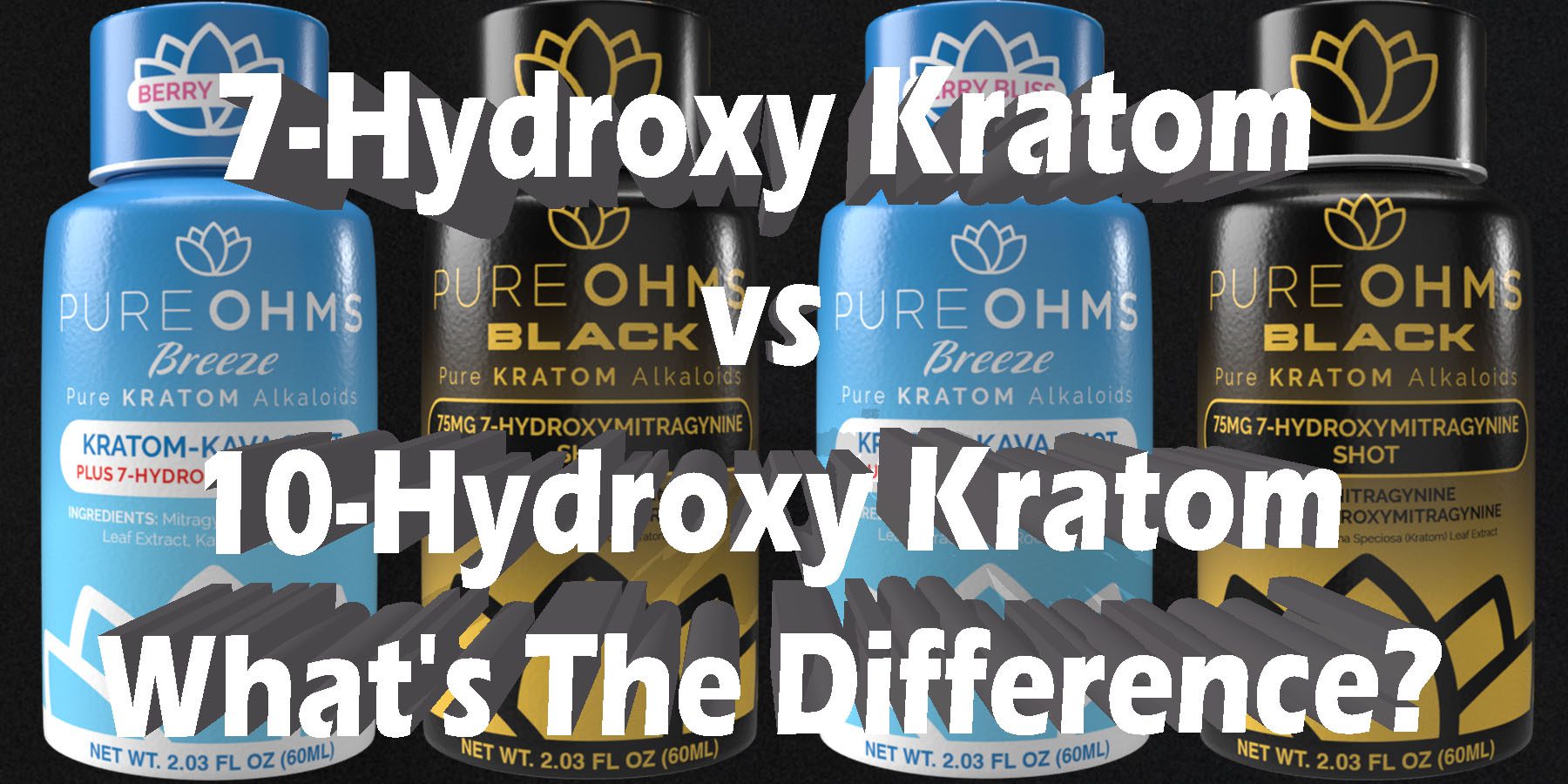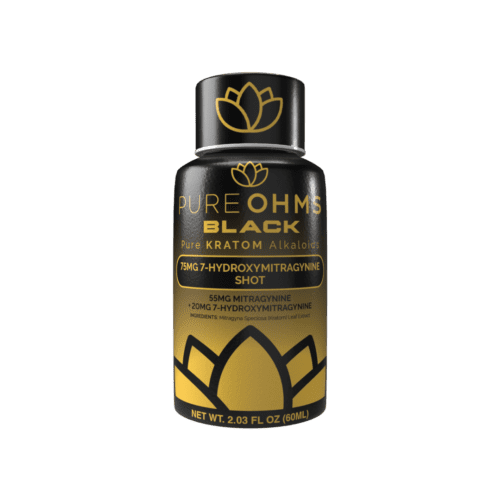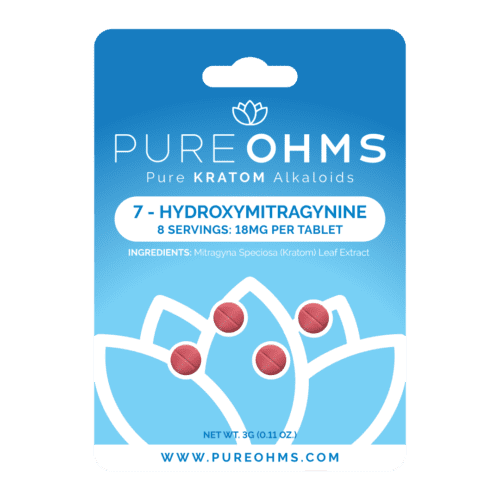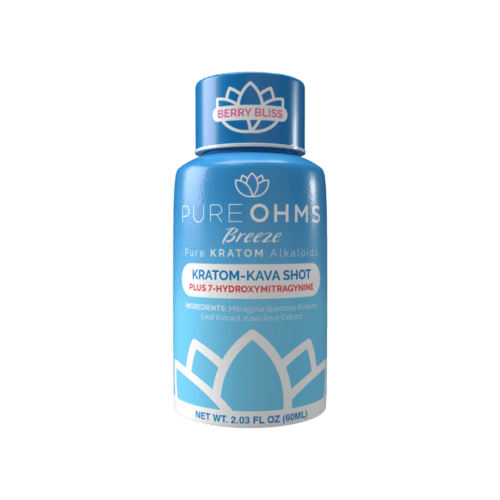
7-Hydroxy Kratom vs 10-Hydroxy Kratom: What’s The Difference?
Kratom (Mitragyna speciosa), a tropical tree native to Southeast Asia, has long been recognized for its unique alkaloids that contribute to its effects. Among these alkaloids, 7-hydroxy Mitragynine (7-HMG) and 10-hydroxy Mitragynine (10-HMG) have garnered significant attention for their distinct properties. Understanding the differences between these two compounds can help you better appreciate their roles in the Kratom experience.
To Buy 7 Hydroxy Kratom Products Click Here
-
Product on sale
 7-Ohms Hydroxy Shot – Black – Pure OHMS$15.99
7-Ohms Hydroxy Shot – Black – Pure OHMS$15.99$49.99
Getting to Know 7-Hydroxy Mitragynine
7-Hydroxy Mitragynine (7-HMG) is one of the most well-known active alkaloids found in Kratom. It’s a secondary metabolite of Mitragynine, the primary alkaloid responsible for Kratom’s characteristic effects. Unlike Mitragynine, 7-HMG is present in smaller quantities but is significantly more potent, contributing to Kratom’s overall potency profile.
Key Characteristics of 7-Hydroxy Mitragynine:
- Potency: 7-HMG is often cited as one of the most potent alkaloids in Kratom, and it is believed to contribute significantly to the plant’s effects even in trace amounts.
- Prevalence: This compound is found naturally in Kratom leaves, albeit in much smaller quantities compared to Mitragynine.
- Receptor Affinity: 7-HMG is known for its strong affinity to certain receptors in the body, enhancing the overall effects of Kratom.
Getting to Know 10-Hydroxy Mitragynine
10-Hydroxy Mitragynine (10-HMG) is a less commonly discussed alkaloid in the Kratom world. Like 7-HMG, it’s also a derivative of Mitragynine but differs structurally, leading to distinct properties and effects. The presence of 10-HMG in Kratom is typically less abundant, and it is considered more obscure compared to its 7-Hydroxy counterpart.
Key Characteristics of 10-Hydroxy Mitragynine:
- Unique Profile: 10-HMG offers a unique profile within the Kratom alkaloid spectrum, contributing subtle but noticeable differences.
- Lower Potency: It is generally considered to be less potent than 7-HMG, but its specific role and effects are still a subject of ongoing research.
- Limited Research: There is comparatively less information available about 10-HMG, making it an intriguing but underexplored component of Kratom.
7-Hydroxy Kratom vs. 10-Hydroxy Kratom: Structural Differences
The primary distinction between 7-HMG and 10-HMG lies in their chemical structures, which influence their effects and interactions within the body. Both are hydroxylated derivatives of Mitragynine, but the position of the hydroxyl group on the molecule plays a critical role in determining their unique characteristics.
- 7-HMG Structure: The hydroxyl group is positioned on the seventh carbon, significantly altering its receptor binding and potency compared to Mitragynine.
- 10-HMG Structure: The hydroxyl group is positioned on the tenth carbon, resulting in a different set of effects that distinguish it from both Mitragynine and 7-HMG.
These structural differences, though subtle, have meaningful impacts on how each compound behaves in the body. 7-HMG’s structure contributes to its high potency and quick onset, while 10-HMG’s configuration lends to a milder profile.
Effects and Perceived Benefits
Both 7-HMG and 10-HMG are part of Kratom’s complex alkaloid mix, but they have different impacts on the overall experience. While avoiding undocumented health claims, it’s worth noting that users often report varied experiences when these alkaloids are present in differing ratios.
7-Hydroxy Mitragynine:
- Enhanced Potency: Users often report that strains high in 7-HMG feel more potent, aligning with the alkaloid’s strong receptor affinity.
- Faster Onset: Due to its powerful nature, 7-HMG is associated with a quicker onset, making its presence noticeable even in small amounts.
- Broad Spectrum: It is believed to contribute to Kratom’s wide-ranging effects, enhancing the plant’s versatility.
10-Hydroxy Mitragynine:
- Milder Impact: Compared to 7-HMG, 10-HMG is often perceived as having a subtler influence on Kratom’s effects, contributing more nuanced changes.
- Distinctive Profile: Its presence may alter the balance of effects in Kratom, making some strains feel different from others, even if they are closely related.
- Less Intense: 10-HMG is generally considered less intense, which could be seen as a positive for those who prefer a milder Kratom experience.
The Role of Alkaloid Ratios in Kratom Strains
Kratom’s effects are not solely determined by one or two alkaloids; rather, it is the intricate balance of many compounds working together. The ratios of 7-HMG and 10-HMG within a particular strain can significantly influence its characteristics.
- High 7-HMG Strains: Strains with a higher concentration of 7-HMG are typically noted for their robust and pronounced effects. They may appeal to those seeking a stronger Kratom experience.
- Balanced Strains: Strains with a more balanced ratio of 7-HMG and 10-HMG offer a unique experience, combining the best aspects of both alkaloids.
- Low 7-HMG/High 10-HMG Strains: These strains may present a gentler profile, ideal for users looking for a less intense interaction.
Factors That Influence Alkaloid Content in Kratom
Several factors influence the concentration of 7-HMG and 10-HMG in Kratom, including genetics, environmental conditions, and processing methods. Here’s how these elements can affect the alkaloid balance:
- Strain Genetics: Different Kratom strains naturally produce varying levels of alkaloids, making some strains more dominant in 7-HMG or 10-HMG.
- Growing Conditions: Sunlight, soil quality, and harvest timing can all impact the alkaloid profile of Kratom leaves, altering the levels of 7-HMG and 10-HMG.
- Processing Techniques: How Kratom is dried and processed also affects its final alkaloid content. Fermentation, sun-drying, and other methods can either enhance or diminish specific alkaloids.
Safety and Considerations
When discussing the differences between 7-hydroxy and 10-hydroxy Mitragynine, it’s important to keep safety considerations in mind. Users should always approach Kratom with care, regardless of the specific alkaloid profile, and should follow responsible usage guidelines.
- Understanding Potency: Due to the higher potency of 7-HMG, strains rich in this alkaloid should be approached with caution, especially for new users.
- Strain Selection: Choosing a strain that aligns with your preferences and desired effects is key. Those seeking a milder experience might prefer strains with a balanced or higher 10-HMG content.
- Product Quality: Ensure that you are sourcing high-quality Kratom from reputable vendors that provide lab testing and transparency about their products’ alkaloid content.
Both 7-Hydroxy and 10-Hydroxy Mitragynine Contribute to Kratom’s Diverse and Complex Nature
Overall, each brings its own set of characteristics to the table. While 7-HMG is known for its pronounced effects and higher potency, 10-HMG offers a subtler experience that still plays a significant role in Kratom’s overall profile.
Understanding these alkaloids allows users to make more informed choices about their Kratom usage, tailoring their experience to better suit their preferences. Whether you’re drawn to the power of 7-HMG or intrigued by the unique profile of 10-HMG, each alkaloid adds a distinct layer to Kratom’s rich tapestry. As with any natural product, responsible use and quality sourcing remain the keys to a positive and satisfying experience.



